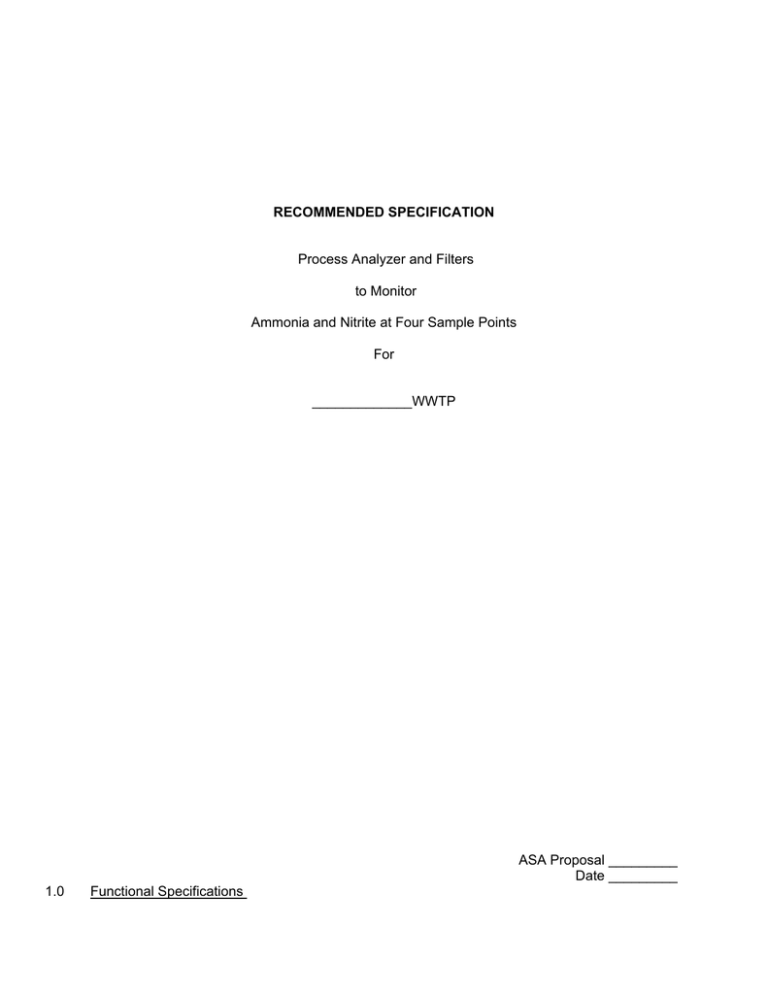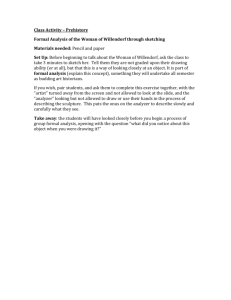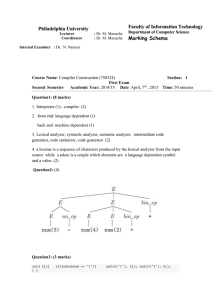4 Sample BNR Spec with Cyclic Filter
advertisement

RECOMMENDED SPECIFICATION Process Analyzer and Filters to Monitor Ammonia and Nitrite at Four Sample Points For _____________WWTP ASA Proposal _________ Date _________ 1.0 Functional Specifications 1.1 Description One on-line nutrient analysis systems for detection of ammonia and nitrate shall be furnished in strict accordance with these specifications. This specification is based on the ChemScan® UV6101 Process Analyzer system manufactured by Applied Spectrometry Associates, Inc. in Waukesha, Wisconsin. 1.2 Manufacturers Qualifications The equipment manufacturer shall have installed multiple parameter nutrient analyzers in at least five (5) municipal wastewater installations in North America each of which have been in operation for a period of at least five (5) years. The nutrient analyzers and accessories shall be furnished by a single manufacturer who shall be responsible for proper operation and interfacing of the equipment. Each nutrient analyzer system shall be capable of analyzing ammonia-nitrogen and nitratenitrogen from four process sample points. Multiple analyzers for each parameter are not acceptable. One complete system shall be furnished to monitor multiple parameters at four sample points. The system shall also be capable of being modified in the field to detect additional parameters such as nitrite or ortho-Phosphorous. 1.3 Analyte Detection Range and Accuracy The analyzer shall be capable of detecting ammonia-nitrogen over the concentration range of 0.1 to 20.0 mg/L, nitrate-nitrogen over the concentration ranges of 0.1 to 15.0 mg/L. Demonstrated accuracy for all parameters in wastewater will be ±5 % or better. Demonstrated accuracy must be based on field performance as defined in Section 1.4. Accuracy shall be measured using the average absolute error, defined as the sum of the absolute differences between the laboratory value for a sample and the equivalent on-line analysis value at the time of sample extraction, divided by the number of samples. 1.4 Experience Requirement Detection ranges and accuracy for ammonia and nitrate must be verified through the availability of data from tests of at least four months duration at a municipal wastewater treatment facility in North America. Comparison samples from test sites shall have been extracted a minimum of 90 times during the test period and independently analyzed in accordance with a standard laboratory analysis method. The following calculations from the test shall be submitted: average absolute error, variance and standard deviation. In addition, references from a minimum of five municipal wastewater treatment sites in North America using the same analytical method for a period not less than 5 years shall be furnished for each parameter. 1.5 Sampling Requirements 2 1.5.1 Sample Frequency The analyzer shall be capable of measuring all parameters from a single sample point within 5 minutes or less, not including sample flush time. The total time required to measure all parameters at two designated sample points, including any time required to flush sample lines and accumulate fresh filtrate for analysis shall be 30 minutes or less. The analyzer system shall be capable of enabling or disabling parameter selections at each sample point and enabling or disabling analysis of any of the sample points through operator initiated commands on the controller screen without the need for external software modifications. 1.5.2 Sample Points The analyzer system shall be configured to monitor two (4) sample points from a BNR process, typically anoxic zone and aeration basin. The analysis cycle shall be automatically initiated and controlled by the process analyzer control system. The analyzer shall also incorporate an additional sample port to manually introduce discrete samples for calibration and quality control testing. 1.5.3 Sample Filtration System The analyzer system manufacturer shall supply a filtration system for rejection of solids in the samples. Because some sample points are early in the process, the solids in samples from these points may not settle readily or fully within a reasonable period of time. Therefore, analyzer systems that rely on sample settling for reduction of solids are prohibited. The preferred system will permit a filtered sample to be drawn directly from each sample point and be delivered to the analyzer for flushing and analysis. The filter system shall include a replaceable filter cartridge with a pore size of 50 micron or less, a rigid support arm and a mounting bracket to secure the support arm and filter assembly to the tank railing at each sample point. The bracket and support arm shall be fabricated from non-corrosive material. All hardware shall be stainless steel. The support arm shall be installed to position the filter cartridge 12 to 18 inches below the surface of the wastewater. A 3/8 inch Tygon sample line shall be installed from the support arm to the analyzer and connected to the analyzer sample inlet. The sample line shall be housed in a rigid PVC pipe for insulation and support. Maximum distance of this line shall be 50 feet. A reversible sample pump and air compressor shall be provided as part of the analyzer system. The analyzer system will reverse the flow of sample and shall purge the sample line and filter with air after each analysis cycle. The analysis time designated in paragraph 1.5.1 shall include all time required for sample flushing and analysis for all parameters at any sample point, including reverse flow and purge cycles. 1.6 Detection Techniques 1.6.1 Approved Techniques The analyzer shall not use ion-selective electrodes or any method that employs reagents for nitrate or nitrite detection. Nitrate and nitrite detection time shall be no greater than 1 minute. The analyzer shall not use ion-selective electrodes or any method that generates a hazardous waste stream including phenate, salycalate, cyanide or mercury based reagents for ammonia. Ammonia detection time shall be no greater than 3 minutes. Multiple-wavelength spectrophotometric detection methods are allowed provided that at least 15 wavelengths used for analysis. The use of deionized water for zeroing and cleaning solutions for optical surfaces is not prohibited. Submittal data shall specify the detection technique to be provided. 3 1.6.2 Reagent Requirements Zeroing and Cleaning solutions shall not need replenishment more than once every two weeks. Reagents for analysis of ammonia once every 7.5 minutes shall not require replenishment more often than once each month. 1.7 Software Requirements 1.7.1 Calibration File Library Storage The analyzer shall be capable of maintaining all necessary calibration data for each analyte plus control instructions for system operation in a nonvolatile memory within the analyzer. In the event of a power loss to the analyzer, all calibration files and operating instructions shall be held intact. The analyzer shall automatically resume operation upon restoration of power. 1.7.2 Correction Due To Interfering Substances The analyzer shall provide for the elimination of interferences due to background substances present during its analyses. Multiple wavelength ultraviolet absorbance spectrometry using a minimum of 15 wavelengths that allows the elimination of interfering substances shall be used as the detection technique. 1.7.3 Reference Wavelength Adjustment Capability During each new light absorbance reading, the analyzer shall compensate for turbidity variations in the sample. 1.7.4 Internal Data Logging Capability The analyzer shall contain an internal memory capable of retaining a record of analytical values with the corresponding date and time for each analyte measurement. This memory shall be battery protected to avoid loss in the event of a power interruption. The memory shall be capable of being accessed through a serial port. At least 750 measurements shall be retained in memory. Software to transfer data log files to an interrogation and logging system shall be provided. 1.7.5 Security Code Capability The analyzer shall contain the capability to deny operational command or menu access through the use of a security code. The analyzer shall also contain the capability for security codes to be changed by an authorized operator. 1.7.6 Calibration Algorithm Construction and Storage 4 Calibrations for the calculation of measurements for each analyte and range specified will be site specific and constructed from field and laboratory data. A backup copy of the calibration algorithm shall be provided on diskette. 1.7.7 Field Calibration File Collection The analyzer shall have a dedicated sample port for the introduction of calibration and test samples. A manual signal shall be available for initiation by an operator to record absorbance signatures in parallel with the extraction of a calibration sample. Software to extract absorbance log files from memory shall be provided. 1.7.8 Zero Adjustment The analyzer shall have the capability of being automatically zeroed using deionized water as the zero standard. The analyzer shall be programmed to automatically initiate zeroing after a specified number of measurements. The analyzer shall automatically zero the instrument using the deionized water standard, automatically check intensity values, signal the need for physical cleaning if intensity values fall below a predetermined standard for reliable analyzer operation, automatically clean the flow cell using a cleaning solution and automatically return the analyzer to on-line operation. The previous 50 auto zero and clean operations shall be logged in internal memory. Software to extract zero log files from memory shall be provided. 1.7.9 Slope/Intercept Adjustment The analyzer shall have the capability for operators to enter calculated slope and intercept adjustments for each analyte calibration, based on laboratory analysis of comparison samples. Software to calculate slope and intercept adjustments shall be provided. 1.8 Communications Capability 1.8.1 Operator Interface The analyzer shall be provided with the ability to display and select menu choices, operational commands and diagnostic information necessary for operation and control of the analyzer. The analyzer shall also display operating status and the most recent analysis results for each parameter. 1.8.2 Analog Data Outputs The analyzer system shall contain the ability to transmit a dedicated 4-20 mA signal scaled to the detection range for each analyte to be monitored in each sample line. The 4-20 mA transmitter shall be capable of producing a signal with an error rate of less than 0.5 percent throughout the scale. Connection points shall be provided for all analog and alarm outputs. 1.8.3 Serial Data Communications 5 The analyzer shall have the ability to transmit all concentration readings over an RS-232 serial communications channel for maintenance purposes in addition to the analog communications capability. 2.0 Equipment Specifications 2.1 Electronics Module 2.1.1 Enclosure The light source and detection system shall be housed in an electronics enclosure rated NEMA 4 or better. All metallic enclosure materials exposed to the atmosphere will be protected using coatings suitable for use in a wastewater environment or will be fabricated using stainless steel. The enclosure shall be secured with a lock and key that are different from the lock and key used to secure the flow cell enclosure. 2.1.2 Keypad and Display An externally mounted display shall be provided. The display shall be back illuminated for observation in low ambient light levels. A keypad shall be provided to enter all operatorselected variables and menu options necessary for routine operation of the analyzer. 2.1.3 Temperature Control The electronics enclosure shall contain an internal temperature measurement and control system for optical stability. This is not a substitute for an indoor or sheltered analyzer location. 2.1.4 Power Connection The electronics module shall contain a terminal block for connection to 110 v, 60 Hz power. Power consumption for the analyzer system shall be a maximum of 10 amps. 2.2 Flow Cell Module 2.2.1 Enclosure A flow cell enclosure shall be furnished, using the same materials of construction and coating systems as the electronics enclosure. The flow cell enclosure shall be rated NEMA 3R or better. The enclosure shall be secured with a lock and key. 2.2.2 Flow Cell Sample flow cell surfaces in contact with the sample flow shall be constructed of corrosion resistant materials. Optical windows in contact with the sample flow shall be quartz. The flow cell shall be sealed to prevent leakage of the sample but shall permit periodic disassembly for physical cleaning of optical surfaces in contact with the sample flow. 6 2.3 Data Communication Enclosure 2.3.1 Enclosure A data communication enclosure shall be furnished in an enclosure rated NEMA 4 or better. The enclosure shall house the data communication and analog output card. 2.4 Shelter Each analysis system including analyzer, data communication module, pump and compressor shall be housed indoors or in a shelter located at or near the treatment basins, such that sample distance from each sample point to the analyzer is not greater than 50 feet. The shelter shall contain a means to assure that the internal temperature remains above freezing and does not exceed 105 F. The analyzer and data communication module shall be wall mounted inside the shelter. The shelter shall be furnished by others, complete with power connections, data communications, sample line inlets, and drain line as required by the analyzer system manufacturer. 7




